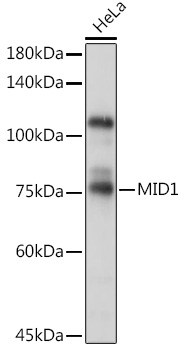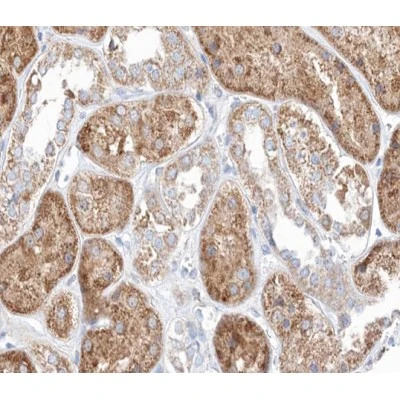MID1 Polyclonal Antibody
RD84397A
ApplicationsImmunoFluorescence, Western Blot
Product group Antibodies
ReactivityHuman, Mouse
TargetMID1
Overview
- SupplierReddot Biotech
- Product NameMID1 Polyclonal Antibody
- Delivery Days Customer5
- ApplicationsImmunoFluorescence, Western Blot
- CertificationResearch Use Only
- Concentration1 mg/ml
- ConjugateUnconjugated
- Gene ID4281
- Target nameMID1
- Target descriptionmidline 1
- Target synonymsBBBG1, FXY, GBBB, GBBB1, MIDIN, OGS1, OS, OSX, RNF59, TRIM18, XPRF, ZNFXY, E3 ubiquitin-protein ligase Midline-1, Opitz/BBB syndrome, RING finger protein 59, RING finger protein Midline-1, RING-type E3 ubiquitin transferase Midline-1, midline 1 RING finger protein, putative transcription factor XPRF, tripartite motif protein TRIM18, tripartite motif-containing protein 18, zinc finger on X and Y, mouse, homolog of
- HostRabbit
- IsotypeIgG
- Scientific DescriptionThe protein encoded by this gene is a member of the tripartite motif (TRIM) family, also known as the RING-B box-coiled coil (RBCC) subgroup of RING finger proteins. The TRIM motif includes three zinc-binding domains, a RING, a B-box type 1 and a B-box type 2, and a coiled-coil region. This protein forms homodimers which associate with microtubules in the cytoplasm. The protein is likely involved in the formation of multiprotein structures acting as anchor points to microtubules. Mutations in this gene have been associated with the X-linked form of Opitz syndrome, which is characterized by midline abnormalities such as cleft lip, laryngeal cleft, heart defects, hypospadias, and agenesis of the corpus callosum. This gene was also the first example of a gene subject to X inactivation in human while escaping it in mouse. Alternative promoter use, alternative splicing and alternative polyadenylation result in multiple transcript variants that have different tissue specificities.
- ReactivityHuman, Mouse
- Storage Instruction-20°C
- UNSPSC12352203






